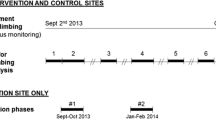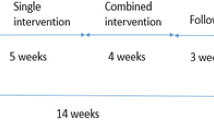Summary
Objectives
Recent recommendations suggest that health benefits can also be derived from regular daily activities of moderate intensity which accelerate breathing, such as climbing stairs. The purpose of this study was to examine the effect of an intervention programme on behaviour change in stair use in a working environment.
Methods
Intervention field workers were instructed to offer attractive or pull actions. 338 employees of four offices of the Swiss federal government were involved in the evaluation. Two methods were used to assess stair and lift use both before and after the four month intervention period: a non-covered personal observation and an automatic measurement.
Results
Taking all four offices together, a significant increase in stair use, from 61.8% to 67.1% (p=0.028), was found between the baseline and the follow-up observation. The automatic measurement during observation time reveals a change in stair use from 68.8% to 71.4% (p=0.268). The pattern of stair use examined for 24 hours by automatic means, however, was not so consistent. Due to the proportion of stair use in each office it is assumed that environmental factors influences the behaviour. The highest percentage of stair use at baseline (86.2%) was identified in an office with a bright stairwell and a small number of steps between floors. The lowest proportion (31.4%) was observed in an office with a dark stairwell, a large number of steps between floors and a stairwell accessible only with a key.
Conclusions
However, our findings indicate that intervention with “rewarding” elements encourage individuals to use stairs.
Zusammenfassung
Fragestellung
Wie neuere epidemiologische Studien zeigen, haben bereits alltägliche Aktivitäten, bei denen man leicht ausser Atem kommt, wie Treppensteigen, gesundheitsförderliche Wirkung. Ziel dieser Studie war, den Effekt eines Interventionsprogramms zur Steigerung der Treppenbenutzung am Arbeitsplatz zu überprüfen.
Methoden
Es wurden vorwiegend “belohnende” Aktionen durchgeführt. Das Programm wurde in vier Ämtern der Schweizerischen Bundesverwaltung mit 338 Mitarbeitern und Mitarbeiterinnen angeboten und evaluiert. Um den Anteil Treppen- und Liftbenutzerinnen vor und nach der vier-monatigen Interventionsperiode zu überprüfen, wurden zwei Erhebungsmethoden angewandt: eine nicht verdeckte Beobachtung und eine nicht verdeckte automatische Zählung.
Ergebnisse
Fasst man die Beobachtungsdaten der vier Ämter zusammen, stieg der Anteil Treppenbenutzerinnen von 61,8% auf 67,1% (p=0,028) an. Bei der während der Beobachtungszeit parallel verlaufenden automatischen Zählung nahm der Anteil Treppenbenutzung von 68,8% auf 71,4% (p=0,267) zu. Bezugnehmend auf die 24-stündige automatische Zählung waren die Daten weniger konsistent. Hinweise auf den Einfluss von Umgebungsfaktoren auf das Verhalten geben die Prozentzahlen Treppenbenutzung in den einzelnen Ämtern. Der höchste Anteil (86,2%) ist in einem Gebäude mit hellem Treppenhaus und niedrigen Stockwerken, der niedrigste (31,4%) in einem Amt mit dunklem Treppenhaus, hohen Stockwerken und nur mit Schlüssel zugänglich.
Schlussfolgerungen
Die Beobachtungsergebnisse unterstützen die These, dass mit sogenannten “netten” Angeboten die Häufigkeit der Treppenbenutzung positiv beeinflusst werden kann.
Résumé
Objectifs
Des études épidémiologiques plus récentes ont démontré qu'on obtenait un effet favorisant la santé rien qu'en exerçant des activités quotidiennes pendant lesquelles on s'essouffle légèrement, comme par exemple monter/descendre les escaliers. Le but de cette étude était de vérifier l'effet d'un programme d'intervention visant à augmenter l'utilisation des escaliers sur le lieu de travail.
Méthodes
Le plus souvent, des actions avec des “récompenses” à la clef ont eu lieu. Le programme a été soumis et évalué dans quatre offices de l'Administration Fédérale Suisse comprenant 338 collaborateurs et collaboratrices. Deux méthodes de recensement ont été appliquées afin de pouvoir vérifier la part des utilisateurs/utilisatrices des escaliers et de l'ascenseur avant et après la période d'intervention de quatre mois: une observation non cachée et un comptage automatique non caché.
Résultats
En réunissant les dates d'observation des quatre offices, la part des utilisateurs/utilisatrices a augmenté de 61.8% à 66.6% (p=0.028). Lors du comptage automatique qui a eu lieu parallèlement à la période d'observation, la part des utilisateurs/utilisatrices des escaliers a augmenté de 68.8% à 71.4% (p=0.267). Quant au comptage automatique sur 24 heures, les données étaient moins consistantes. Les chiffres en pour cent de l'utilisation des escaliers pour chaque office donnent des indices sur l'influence que des factuers d'environnement ont sur le comportement. La part la plus élevée (86.2%) a été relevée dans un immeuble avec une cage d'escaliers claire et des étages bas, la moins élevée (31.4%) dans un office avec une cage d'escaliers sombre, des étages hauts et accessible uniquement à l'aide d'une clé.
Conclusions
Les résultats de l'observation soutiennent la thèse qu'avec les prétendues offres «agréables», la fréquence d'utilisation des escaliers peut être influencée de manière positive.
Similar content being viewed by others
References
Blair SN, Kohl HW, Barlow CE, Paffenbarger RS, Gibbons LW, Macera CA. Changes in physical fitness and allcause mortality. JAMA 1995;273: 1093–8.
U.S. Department of Health and Human Services. Physical activity and health: a report of the Surgeon General, Atlanta, GA: U.S. Department of Health and Human Services, 1996.
Mutrie N, Biddle SJH. The effects of exercise on mental health in nonclinical populations. In: Biddle SJH, ed. European perspectives on exercise and sport psychology. Champaign, IL: Human Kinetics, 1995: 50–70.
Lee IM, Hsieh CC, Paffenbarger RS. Exercise intensity and longevity in men. JAMA 1995;273: 1179–84.
WHO. Preventing and managing the global epidemic. Report of a WHO Consultation on obesity. Geneva: WHO, 1999.
Shephard RJ. What is the optimal type of physical activity to enhance health? Br J Sports Med 1997;31: 277–84.
Pekka O, Vuori I, Paronen O. Daily walking and cycling to work: their utility as health-enhancing physical activity. Patient Educ Couns 1998;33: 87–94.
Martin BW, Marti B. Bewegung und Sport: eine unterschätzte Gesundheitsressource. Ther Umsch 1998;55: 221–8.
Hättich A. Bewegung und Sport in der Schweiz. Magglingen: Eidgenössische Sportschule, 1995. (Schriftenreihe der ESSM; 65).
Calmonte R, Kälin W. Körperliche Aktivität und Gesundheit in der Schweizer Bevölkerung. Eine Sekundäranalyse der Daten aus der Schweizerischen Gesundheitsbefragung 1992, Bern: Institut für Sozial-und Präventivmedizin, 1997.
Dunn AL, Marcus BH, Kampert JB, Garcia ME, Kohl III HW, Blair SN. Comparison of lifestyle and structured interventions to increase physical activity and cardiorespiratory fitness. JAMA 1999;281: 327–34.
Pratt M. Benefits of lifestyle activity vs structured exercise. JAMA 1999;281: 375–6.
Blamey A, Mutrie N, Aitchison T. Health promotion by encouraged use of stairs. BMJ 1995;311: 289–90.
Brownell KD, Stunkard AJ, Albaum JM. Evaluation and modification of exercise patterns in the natural environment. Am J Psychiatry 1980;137: 1540–5.
Prochaska JO, DiClemenete CC. Stages and processes of self-change in smoking: towards an integrative model of change. J. Consult Clin Psychol 1983;59: 295–304.
Marcus BH, Simkin LR, Pinto BM. Longitudinal shifts in employees' stages and process of exercise behaviour change. Am J Health Prom 1996;10: 195–200.
Author information
Authors and Affiliations
Corresponding author
Rights and permissions
About this article
Cite this article
Titze, S., Martin, B.W., Seiler, R. et al. A worksite intervention module encouraging the use of stairs: Results and evaluation issues. Soz Präventivmed 46, 13–19 (2001). https://doi.org/10.1007/BF01318794
Issue Date:
DOI: https://doi.org/10.1007/BF01318794




